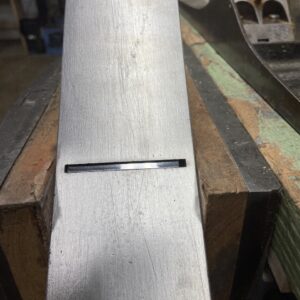How wide is the mouth or your Stanley #6 plane
I have an older #6, bought at an estate sale, that I’ve been putting back to order. Today I placed a Hock iron and chip breaker on this plane and found there was no gap between the mouth and the iron when I advanced it to make a shaving. I tried it with an original Stanley iron and found the same thing. If I advance it far enough to be useful there’s no clearance at the mouth of the plane as it passes through the sole. Something seems really weird when I look at this. I decided to be scientific about it and get my dial digital caliper to compare it with some of my other planes. The number 6 measured nominal 5/32 . A Stanley #7 measured 23/128 and a craftsman #7 a friend gave me was 25/128. All of these are vintage tools, I’ve done nothing more than cleaned and flattened the soles. This picture may not be the best example.
Would anyone know how wide the mouth of a #6 plane should be?
















Replies
Can you bring the frog in some?
Remember, the plane works for you, not the other way around. Do what it takes to make it work.
Thanks. Yes, I’ve tried moving the frog as much as possible. Seems like I really should pull out a file and remove at least 1/32 or more from the leading edge of the mouth. I just can’t understand how this plane was productive in the past.
Sometimes you need to file the mouth when switching to a thick aftermarket blade.
But you shouldn't ever have to when using a stock Stanley blade. That tells me the frog isn't adjusted correctly.
I have no idea what the measurement should be for a mouth opening. I've never considered measuring one. It should be just big enough to let a shaving through. Very thick for a jack, very fine for a smoother.
The diff in the stanley mouth numbers from the 6 to 7 is only about .o2 ...feels like a setup issue. Take it apart and check for correct parts & assembly. The departed owner may have messed it up or frankenplaned it years ago.
I have never had to fettle to put in a Hock iron.
Thanks all. Does seem odd however there’s not much left to setup when I just measured the opening in the sole. That doesn’t care about the frog.
If the frog is too far forward, it's a problem.
Install the frog so you can just move it back and forth with a little effort. Not too tight, not too loose. Install the blade and lock down the cap. The blade, tight to the frog, should also be touching the plane body. If there is a space, the blade is unsupported, and will chatter. And if there is a space, there will be no clearance for shavings to get through.
The old ones are narrower and the corrugated planes narrower still. Don't know why on the corrugated, but I've noticed it enough times that it can't be an outlier.
I’ve observed there are more problems related to the thickness of the iron in combination with a thick chip breaker. The combined thickness will prevent the iron from seating properly. I could clearly see the yoke that should poke through the hole in the chip breaker. I think I saw Paul Sellers discussing the topic on his website.
This forum post is now archived. Commenting has been disabled